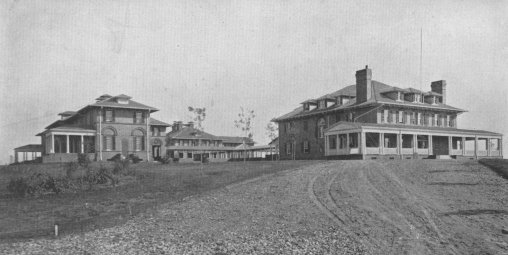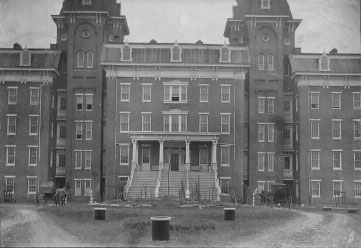
Further information on all of these institutions can be found in the Lunacy Commission Reports listed in this tab. These reports contain a great deal of information, so it is strongly encouraged that you use the Ctrl - F search function. Hit the "Ctrl" and "F" keys at the same time and a search box will appear in the upper right corner of your screen. Enter a keyword, for example "Crownsville" or "Montevue," and your search box will automatically link you to every occasion on which that term is used in the document.

Image made available through the Maryland State Archives.
In operation as early as 1765, county almshouses were initially established as workhouses to which the poor could be "sentenced" and sent to work for their keep. They were intended to be self-sufficient facilities supported by the labor of their residents, but because they were occupied solely by individuals (both adults and children) who were either physically or mentally unable to support themselves and had no family to support them, this was a flawed concept and county almshouses generally had to rely on county taxes. Residents of the almshouse tended to be elderly, infirm, physically handicapped and/or mentally ill. In 1817 many mentally ill patients began to be re-routed to the newly established Maryland Hospital, and later to other successive State Hospitals, but patient segregation and the lack of specific provisions for African American patients meant that they continued to fill the almshouses until the building of the Crownsville State Hospital.
The Hospital at Baltimore began as a temporary and primarily general medical facility sometime in the 1790s in the midst of repeated outbreaks of yellow fever. It was not devoted exclusively to the treatment of mental illness until 1834, when management was turned over to the State. It was not an all-white facility, though patients were most likely segregated. A visitor touring the institution in 1824 wrote:
"It is against the rules of the institution to suffer strangers to see the insane; this prohibition proceeds from motives of delicacy towards the friends and relations of those afflicted, who do not wish them exposed. The doors of their cells are secured with bars of iron and heated by furnaces placed on the outside of the wall, one to every room, which conveys heat to the patient. I looked into some of these cells, which were vacant; they were similar to those occupied by the sick, excepting the bedsteads, which were of iron, and without chairs or tables. Though I could not see the unfortunate beings, I could hear them utter the most shocking oaths."
From The Hospital at Baltimore


The second oldest psychiatric institution in the United States, Spring Grove was founded in 1797 but originally began life in 1794 as "The Retreat," an infirmary for sailors. According to annual reports, the hospital was accepting African American patients well before the Civil War, though often in less than adequate facilities.
"At first, the new facility at Spring Grove seems to have been racially integrated. However, several annual reports from the end of the 19th-century indicate that by that time African-American patients were segregated to certain (less desirable) sections of
the Main Building. For example, it was noted that in 1896 an old bowling alley that was, evidently, located in the basement of the Main Building, was converted to serve as a ward for African-American patients. (The Annual report of that year suggests that, unlike any of the other units in the hospital, the single African-American ward served both male and females patients.) Records from the turn of the 19th-century also indicate that African-American men often lived in tents on the Hospital's grounds for as many as eight months out of the year."
Excerpt taken from African Americans and Spring Grove Hospital

Springfield Hospital, the second hospital for the insane of the State of Maryland, was founded in 1896. It's campus was the first Maryland institution to implement this modern "colony" organizational plan. The colony plan, developed in the 1880's, advocated decentralizing the facility into smaller, seperate clusters of geometrically organized buildings... At Springfield, the colony model was first employed at the Martin Gross Group, a facility for male patients; the plan was refined and improved in the development of the Warfield Service Group for women... The Warfield Service Group is also significant in that its construction allowed for compassionate medical care to be given to the state's indigent insane female population. Previous care favilities frequently consisted of almshouses, jails or for the comparatively fortunate unskilled family or friends. The gaps that these people could fall through prior to Springfield's creation were many and wide.
Excerpt from the Warfield Complex National Register of Historic Places Registration Form.

Established in approximately 1870, the Montevue Hospital was located in Frederick Maryland and, by 1877, served the second largest population of mentally ill and indigent in the state of Maryland. This included many patients from outside the county who were accepted at the hospital for a fee. This led to drastic overcrowding and the hospital was cited on several occassions by the Lunacy Commission as being shockingly lax in it's standards.